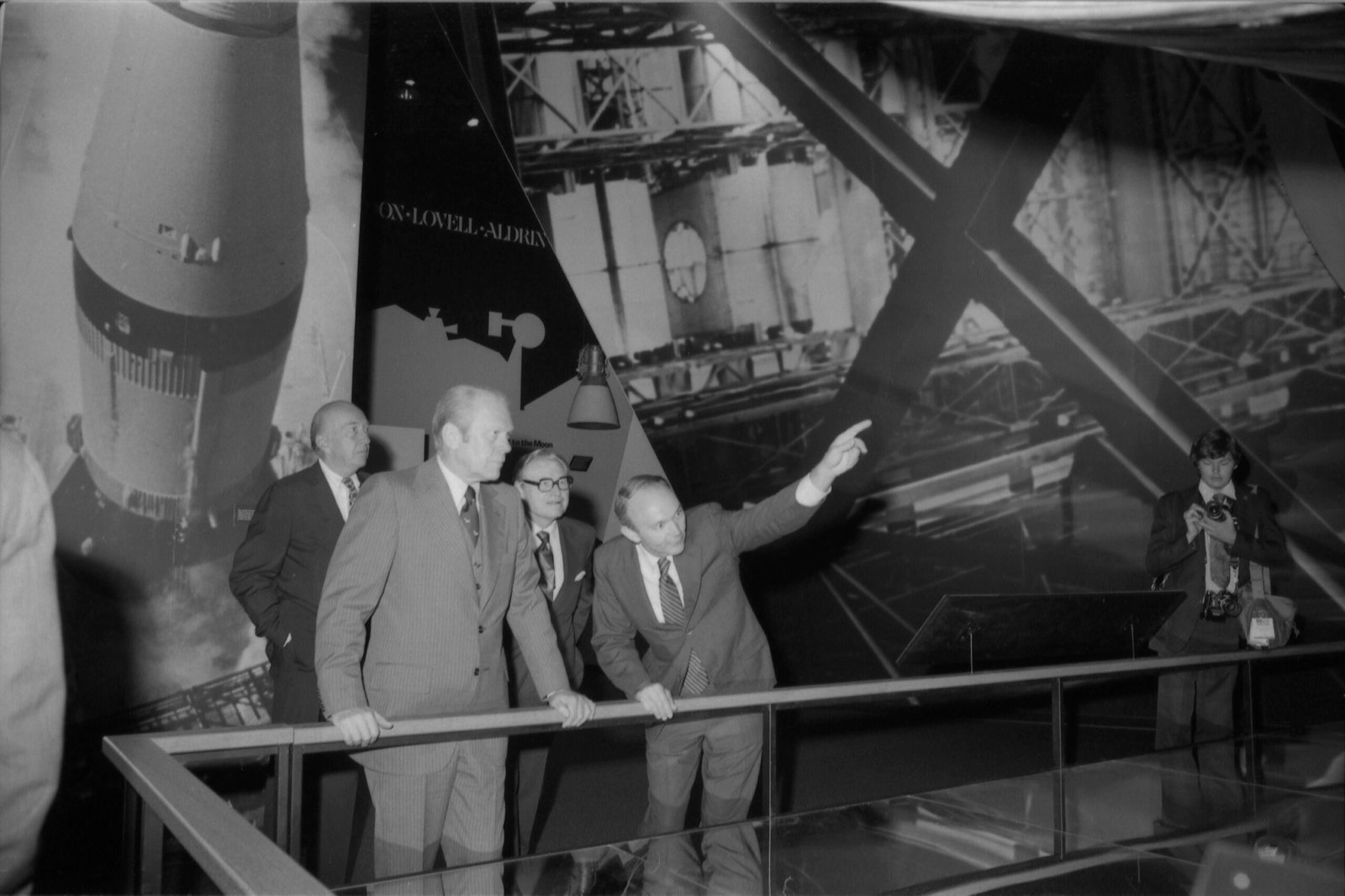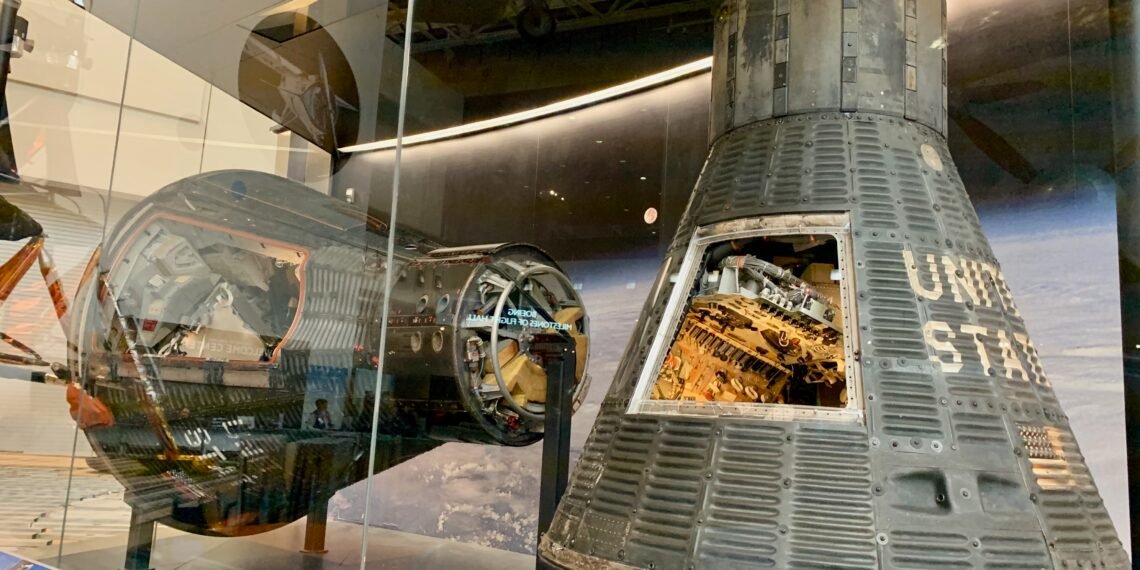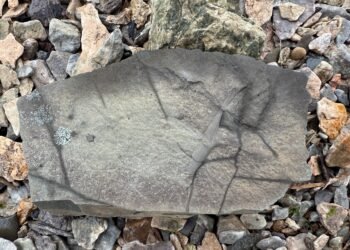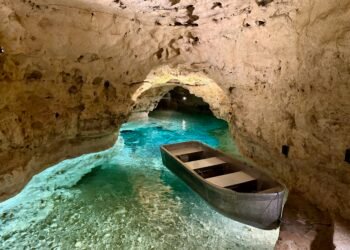The National Air and Space Museum in Washington, D.C., brings aviation and space history to life. Join me as I share highlights from my visit – from the Wright Flyer to the Apollo lunar lander and Hubble Telescope, and discover why this Smithsonian icon is a must-see for science and history lovers alike.
1 Exploring the National Air and Space Museum
In November, I traveled to Washington, D.C., for work and seized the opportunity to spend my Sunday exploring the iconic National Mall area, home to some of the nation’s most captivating attractions. Among these highlights is the National Air and Space Museum of the Smithsonian Institution, a treasure trove of aviation and space exploration wonders that captivates visitors with its rich displays and exhibits.
This visit marked my third experience at this remarkable museum, and each time, I am filled with child-like wonder and anticipation, eager to rediscover its timeless displays.

The National Air and Space Museum, established in 1946 as the National Air Museum, has evolved into one of the most visited museums in the world. Officially opening its doors in 1976, it serves as a repository for the nation’s aviation and space exploration milestones. Over the years, it has expanded to include thousands of artifacts, from early gliders to spacecraft that have ventured beyond Earth’s atmosphere.
2 Quick Facts about the National Air and Space Museum
- Location: Washington, D.C. (National Mall) with a second site at the Udvar-Hazy Center near Dulles Airport.
- Part of: The Smithsonian Institution (free admission).
- Opened: July 1, 1976.
- Annual Visitors: Over 8 million – making it one of the world’s most visited museums.
- Famous Exhibits: 1903 Wright Flyer, Apollo 11 Lunar Module, Spirit of St. Louis, and the Hubble Space Telescope model.
- Tickets: Free, but timed-entry passes may be required (check the official Smithsonian website).
- Renovations: Ongoing upgrades since 2018, with new galleries reopening in phases.
- Best For: Science enthusiasts, history buffs, families, and anyone fascinated by flight and space.
3 A Smithsonian Legacy in Flight
The National Air and Space Museum opened its doors on July 1, 1976, as part of America’s bicentennial celebrations. From the start, its mission was to preserve and showcase the nation’s achievements in aviation and space exploration, while inspiring future generations to look skyward.

Credit: Smithsonian Institution Archives
The museum’s origins stretch back to 1946, when the Smithsonian created the National Air Museum to collect and display historic aircraft. By the 1970s, the growing collection of aviation and space artifacts demanded a larger home. The modern building on the National Mall in Washington, D.C. became that centerpiece – a place where visitors could encounter everything from the 1903 Wright Flyer to artifacts of the Apollo missions.
Over the decades, the museum has grown to become the most visited museum in the world, with millions of guests each year. In 2003, a second facility – the Steven F. Udvar-Hazy Center near Dulles Airport, opened to house larger artifacts like the Space Shuttle Discovery, SR-71 Blackbird, and Enola Gay.
Today, the National Air and Space Museum continues to evolve, undergoing major renovations that will transform its galleries for new generations, while preserving its role as a Smithsonian treasure where the story of flight, from Earth to the stars, is told.
4 The Iconic Lunar Lander
As I entered the museum, I was immediately greeted by a replica of the lunar lander from one of the Apollo missions, proudly displayed in the main atrium. The sight of this iconic spacecraft made me pause in awe. It was hard to fathom that astronauts had actually used such a craft to land on the moon’s surface, conduct their mission, and then return to orbit before heading back to Earth.
This machine, suspended gracefully above the floor, was a stark reminder of the ambition, risk, and profound dedication that defined the space race. I thought about the grainy footage of Neil Armstrong taking those historic steps and how this spacecraft played a crucial role in that monumental event.

The 1960s were a time of high stakes and fierce competition. The lunar lander symbolized the culmination of countless hours of research, innovation, and sheer willpower. Standing there, I could almost hear the echoes of mission control and imagine the tension of that final descent onto the lunar surface.
The engineering challenges faced by NASA teams were monumental, from perfecting the spacecraft’s propulsion systems to devising ways for astronauts to safely explore and return with lunar samples. Each detail spoke to the ingenuity and courage of those who dared to push the boundaries of human capability.
5 The 1903 Wright Flyer
One of the highlights of my visit was seeing the original 1903 Wright Flyer. Standing before this legendary aircraft, I felt an overwhelming sense of elation. This was the very machine that Orville and Wilbur Wright used to achieve the first powered, controlled flight at Kitty Hawk, North Carolina.
The Flyer’s delicate-looking frame, constructed from wood and fabric, was a testament to the brothers’ ingenuity and determination. To think that this modest aircraft was the beginning of modern aviation was humbling. It reminded me of how far humanity has come in the span of just over a century, from this pioneering flight to space travel and beyond.

As I stood there, I let my imagination transport me to that windy December day in 1903. The Wright brothers, clad in their coats and caps, must have felt a mix of hope and trepidation as they prepared for their groundbreaking attempt. The historical weight of the moment seeped into my thoughts, and I felt a deep respect for the courage it took to dream so boldly.
It was fascinating to reflect on the technical challenges they faced, such as crafting a lightweight engine and building a propeller that could generate enough thrust for flight. The Wright Flyer is more than an artifact; it is a testament to the power of innovation and perseverance.
You Might Also Like:
- Natural History Museum London: Discover Nature’s Wonders – Explore one of the world’s greatest museums, where fossils, gemstones, and wildlife exhibits reveal Earth’s natural history.
- National Museum of Nature and Science Tokyo: What to See – Discover Japan’s premier science museum, showcasing dinosaurs, space exploration, and hands-on exhibits for curious minds.
- Miraikan Tokyo: Where Science Shapes Tomorrow – Step into the future at Tokyo’s cutting-edge science museum, with robotics, AI, and space technology exhibits that inspire innovation.
6 The Hubble Space Telescope
Being an amateur astronomer, I was especially thrilled to see a life-sized replica of the Hubble Space Telescope. I was struck by its impressive size, a stark reminder that space exploration requires robust and sophisticated equipment. The Hubble’s incredible images, such as the famous Ultra-Deep Field photograph, have fundamentally transformed our understanding of the universe.

I recalled the early issues the telescope faced shortly after its launch in 1990, with its flawed primary mirror that blurred images. It was inspiring to remember how NASA conducted a series of complex servicing missions using the Space Shuttle to correct the issue, showcasing the resilience and ingenuity of scientists and engineers.

Credit: NASA and the European Space Agency (ESA)
Standing before the replica, I reflected on the photographs Hubble has sent back – snapshots of galaxies colliding, nebulae glowing in vibrant hues, and the haunting beauty of the star-studded cosmos. The telescope’s story of initial setbacks and eventual triumph resonated deeply, reminding me that even the most ambitious projects can stumble before they soar. The Hubble’s legacy is not just the images it captured but also the lessons in adaptability and problem-solving that it imparted to the world.
7 Cold War Missiles on Display
Next, I found myself drawn to the section displaying missiles, including the formidable Minuteman III missile. I was awestruck by its sheer size and the imposing presence it commanded. Standing tall, the missile represented a significant chapter in Cold War history.
These missiles, I assumed, must have been strategically placed in silos across the United States, serving as silent sentinels prepared to defend the nation with nuclear payloads if necessary. I couldn’t help but wonder about the immense resources and costs involved in developing such technologies during a period marked by intense rivalry between global superpowers.

The missile exhibit took me back to the tension-filled decades when the world teetered on the brink of nuclear confrontation. Seeing this artifact in person was a stark reminder of the delicate balance of power that defined the era. It was an uneasy yet captivating experience to witness the sheer force that underpinned the geopolitical struggles of the 20th century.
I imagined the men and women who worked tirelessly in command centres, monitoring missile silos and interpreting satellite data, knowing that one wrong move could change the course of history forever.
8 The Soviet Space Program
As I continued through the exhibits, I came across a Soyuz capsule, part of the Soviet Union’s space program. This piece of engineering was a testament to the parallel space race efforts of the USSR. Also on display was a replica of Sputnik 1, the world’s first artificial satellite, served as a reminder of how the space age truly began. Launched in 1957, Sputnik transmitted telemetry beacons as it orbited Earth, signaling the Soviet Union’s significant early achievement and igniting a fierce competition with the United States.

Looking at Sputnik, I imagined the shock and awe that must have reverberated through the U.S. when its beeping signal was first detected. It marked the dawn of a new era – one where space became the next frontier for technological and ideological dominance.
The Soyuz capsule, too, was a marvel of its time, reflecting the Soviet Union’s pragmatic and robust approach to space travel. The exhibits reminded me that history is not a singular story but a series of intertwining narratives from different perspectives. The Soviet engineers’ achievements underscored the importance of perseverance and innovation in a high-stakes environment.
9 Mercury Friendship 7 Capsule
Another remarkable sight was the Mercury Friendship 7 capsule. This historic vessel carried astronaut John Glenn in 1961, making him the first American to orbit Earth. The burn marks on the capsule’s exterior were still visible, a tangible reminder of the intense heat and friction it endured during re-entry. Standing before it, I marveled at the bravery of those early astronauts who risked their lives to push the boundaries of what was possible.

I found myself imagining Glenn’s perspective as he gazed out at Earth from orbit—the vast blue planet suspended in the inky darkness of space. The Mercury missions were the pioneering steps that laid the groundwork for future triumphs in space exploration. Witnessing this capsule up close made those stories feel vivid and immediate, as if I could almost hear the crackling radio transmissions from mission control. I thought about the rigorous training these astronauts endured, preparing for the unknown with unyielding determination.
10 The Mars Viking Lander
One of the most exciting moments during my visit was seeing a demonstration of the Mars Viking Lander. As I examined the intricacies of this probe, I couldn’t help but be captivated by the challenges engineers must have faced in designing and launching a spacecraft capable of reaching Mars, landing safely, and transmitting valuable data back to Earth. My fascination with space exploration grew even deeper as I imagined the countless hours of research, testing, and problem-solving that made such missions successful.

The Viking Lander, perched in the exhibit with its spindly legs and complex sensors, stood as a monument to human curiosity and tenacity. The 1970s were a different time, yet the desire to push the boundaries of the known world was just as fierce.
I lingered, thinking about the data it sent back—the first close-up images of the Martian surface and groundbreaking findings that paved the way for future Mars missions. The dedication of scientists who pored over these early Mars images, seeking signs of water and life, spoke to the deep human desire to explore and understand the cosmos.
11 The Legacy of LORAN
A particularly intriguing exhibit was a diagram of the global LORAN (Long Range Navigation) coverage map from 1945. This legacy navigation system played a vital role in marine travel, allowing mariners to determine their location using radio signal triangulation.
It reminded me of other navigational aids, such as the U.S. Navy’s VLF (Very Low Frequency) station in Cutler, Maine, near my hometown in New Brunswick, Canada, which broadcasts low-frequency signals for submarine communication. While GPS has become the standard for navigation today, it was fascinating to see how this was achieved in an earlier era.

Looking at this legacy system, I felt a sense of connection to a bygone era where technology was just beginning to transform global travel and communication. It was a quiet reminder that progress is built layer by layer, with each
12 Practical Travel Tips for Visiting the National Air and Space Museum
For those planning a visit to National Air and Space Museum, here are a few practical tips:
- Plan Your Visit Early: Arrive early to beat the crowds, especially during weekends and holidays.
Admission: Entrance to the museum is free, but check online for any special exhibits or shows that may require tickets. - Security Check: Be prepared for a security screening at the entrance. Keep your bags minimal to speed up the process.
- Visit Duration: Allocate at least 3-4 hours for your visit to fully appreciate the exhibits and interactive experiences.
- Guided Tours: Consider joining a guided tour or downloading the museum’s mobile app for self-guided tours with audio insights.
- Lunch Breaks: The museum has a café, but it can get busy. Alternatively, you can explore nearby eateries at the National Mall.
- Accessibility: The museum is wheelchair accessible and offers assistive listening devices for visitors.
- Gift Shop: Don’t forget to visit the gift shop for unique souvenirs related to aviation and space.
13 Pro Tips for the Science Traveler
For those with a passion for science, aviation, or space exploration, the National Air and Space Museum provides an unparalleled experience. Here are a few pro tips to help you make the most of your visit:
- Dig Deeper: Bring a notebook or use a notes app to jot down interesting facts or questions that inspire further research.
- Photography: Take photos of the lesser-known exhibits or displays that resonate with your interests for later reference.
- Special Exhibits: Check the museum’s website ahead of time for rotating exhibits or special events focused on scientific discoveries.
- Interactive Zones: Spend extra time in hands-on sections like the How Things Fly gallery to get a deeper understanding of physics and engineering principles.
- Attend Talks: Look out for special guest lectures or live demonstrations conducted by scientists and historians.
- Beyond the Main Museum: If time allows, plan a visit to the Steven F. Udvar-Hazy Center in Virginia, which houses larger aircraft and space shuttles.
- Astronomy Enthusiasts: Visit the planetarium and catch a show that aligns with your interest, such as deep space exploration or solar system tours.
- Connect with Fellow Travelers: Strike up conversations with other visitors who share your passion for science. You might get valuable tips or insights!
14 Reflections on the Visit
As I wrapped up my visit, I reflected on the powerful blend of history, science, and human ambition that the National Air and Space Museum represents. The exhibits, from the pioneering 1903 Wright Flyer to the awe-inspiring replicas of space exploration marvels, tell a story of boundless curiosity and relentless pursuit of knowledge. Each artifact encapsulates a chapter of human history where imagination met engineering and turned the impossible into reality.
This museum is more than just a repository of artifacts; it is a living tribute to the spirit of exploration. Walking through its halls, I felt deeply connected to the shared legacy of all those who dared to push beyond the known and venture into the uncharted. Whether it was the Wright brothers in their humble workshop or the engineers piecing together the Apollo lander under tight deadlines, their stories remind us of the power of vision and determination.
For the science traveler, the lifelong learner, and the experience seeker, the National Air and Space Museum is a treasure trove of discovery. It invites you to explore, learn, and be inspired by the vast potential of human ingenuity. As I left the museum and stepped back onto the National Mall, I carried with me not just memories but a renewed sense of wonder and a deeper appreciation for the journey of innovation that continues to propel us forward.










